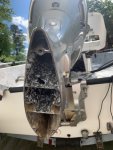I work on a lot of these 40-50 hp Hondas, but I've never seen one that bad. I'd be pretty concerned over what the inside of the engine looks like after seeing that.
That said, I say as long as the lower unit can supply water to the power head and keep water out of the lower unit lube, go ahead and run it into the ground. Keep an eye peeled on the engine oil dipstick . When you see milky oil or water droplets mixed with the engine oil, time to pull this engine from service. Judging by what the lower unit looks like this engine won't be worth fixing.
The upside is that when it does die, even though it's very likely going to be pretty used up, ALL of the parts are interchangeable with 40's and 50's built prior to 2004 or so. You might be able to find a parts motor on the cheap and build yourself a motor that will last quite a while using parts from this engine (e.g. carbs, ign. parts, starter, drive shaft, etc.) .
The older motors (especially those run in a salty environment) do have a pretty common issue. The bottom of the steering tubes are frequently rusting from the inside out, and haven't been made for a while now. Make sure your new motor has something to work with there! Best of luck! -Al





















